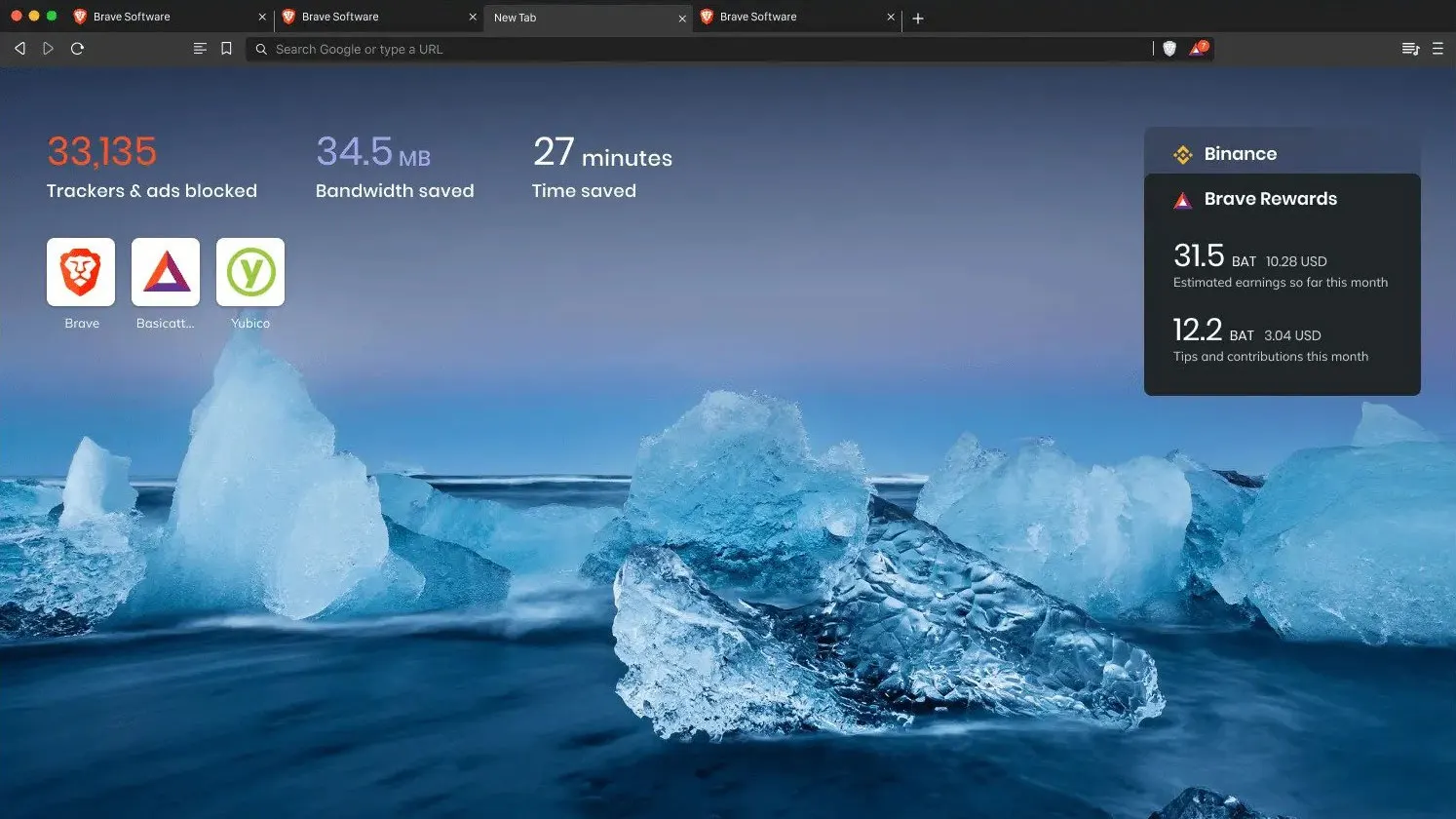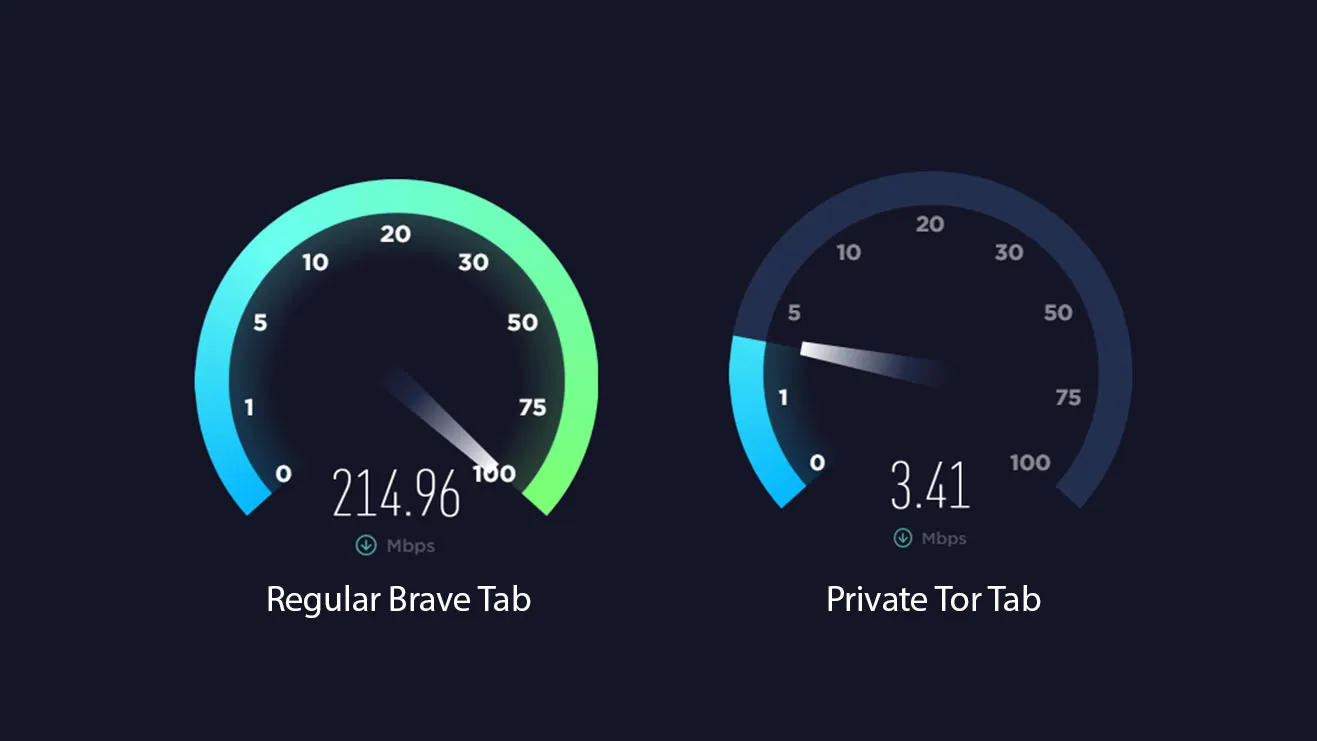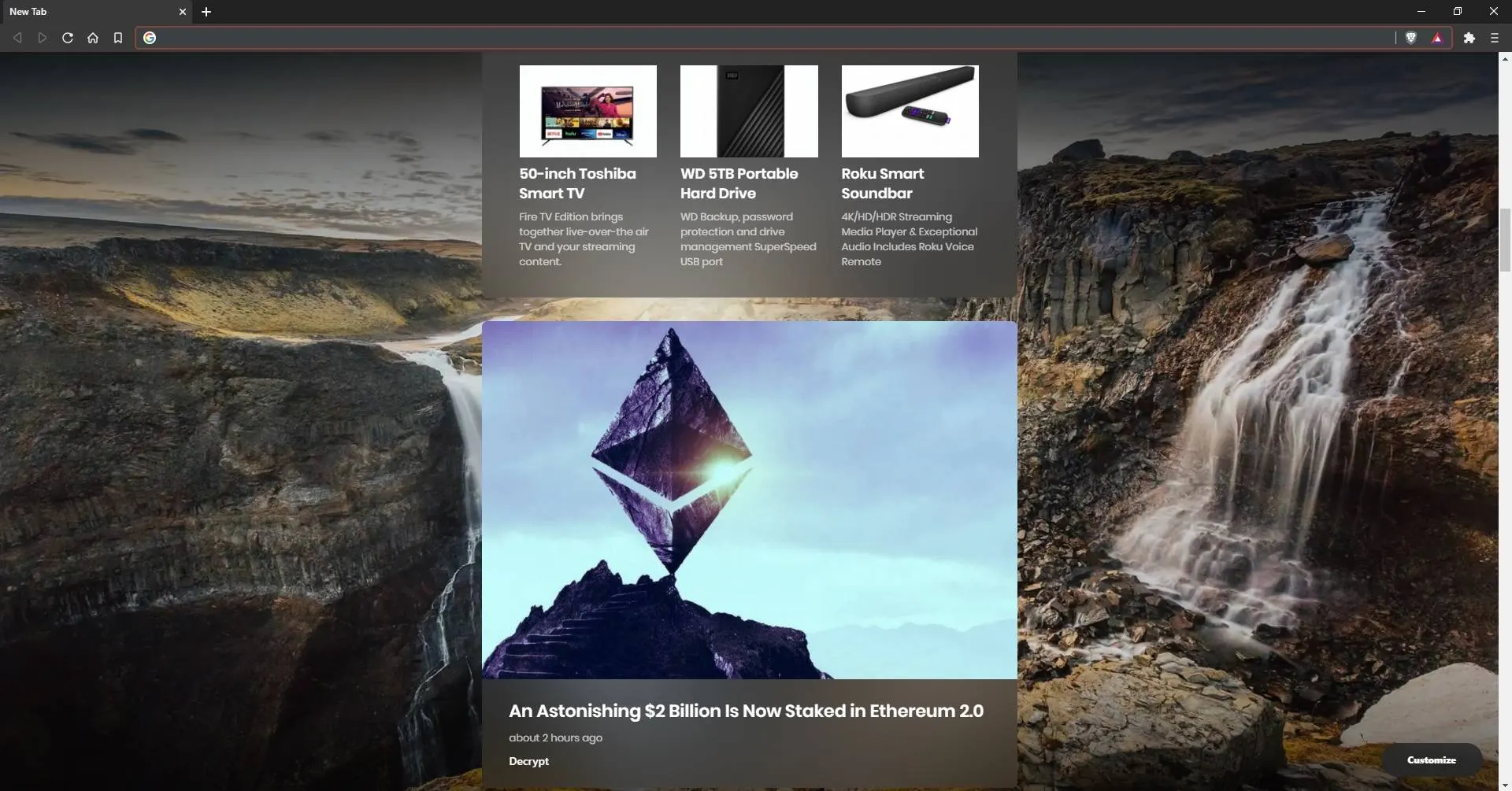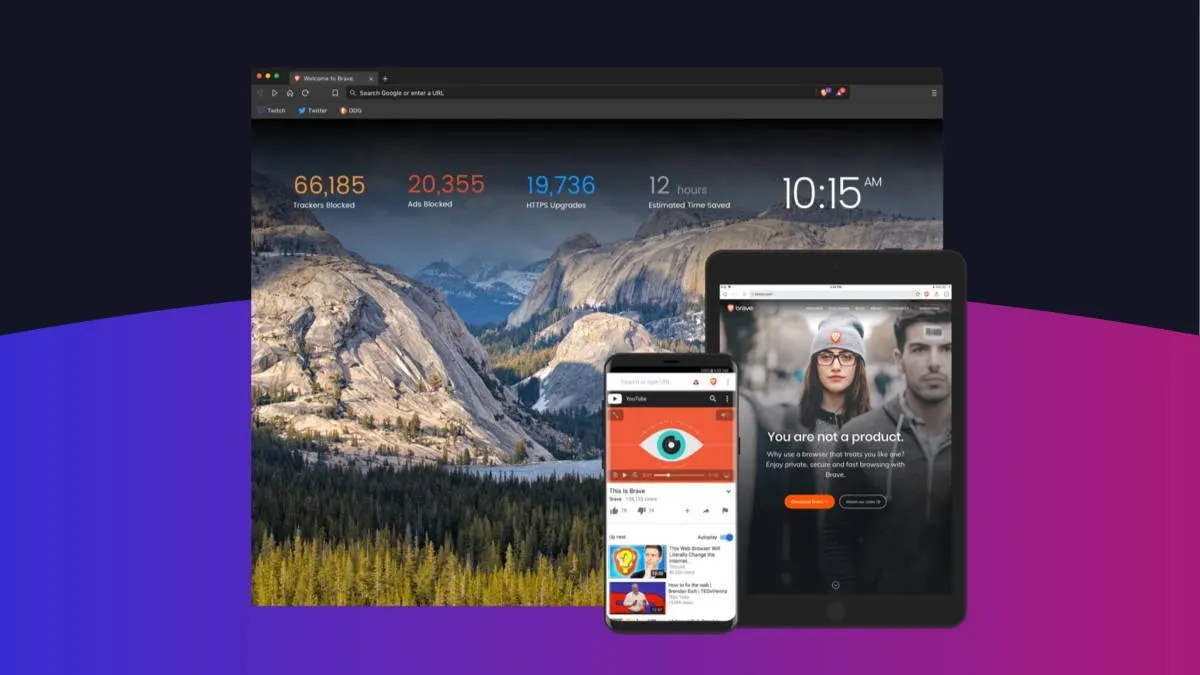In brief
- Brave browser is a privacy-first browser that blocks ads by default.
- Users can earn Basic Attention Token (BAT) cryptocurrency by viewing privacy-preserving ads on Brave.
Jump to
Do you remember the dark days of Internet Explorer? We do. In the face of its slow, buggy, and downright unpleasant interface, the arrival of alternative browsers like Firefox and Google Chrome was an absolute godsend.
Now there’s a (relatively) new kid on the block, and it’s powered by crypto: Brave Browser.
What is Brave Browser?
Brave Browser is a privacy-first, crypto-powered browser that blocks websites from tracking you by default.
Launching a new browser into the current marketplace might seem like a fool’s errand for Brave. Google Chrome, the market leader, has gobbled up nearly two-thirds of the global market share. Apple’s Safari comes in a distant second, with 19%, while Mozilla’s Firefox brings up the rear at 4%.
Brave, however, reckons that its focus on user privacy sets it apart from the competition. Forged by the creator of JavaScript and co-founder of the Mozilla Project, Brendan Eich (who was also responsible for Firefox), Brave’s primary goal is to redefine how we think about browsing the web, by blocking websites from tracking you, and rewarding you with cold, hard crypto for watching ads instead.
That’s right: Brave users can actually earn revenue in the form of Basic Attention Token (BAT) by opting to view anonymous, privacy-preserving ads. The company’s ad network, which launched in November 2019, provides users with an option to watch these anonymous ads, before being paid in BAT. The service is optional, and you’re more than welcome to leave all ads blocked and turned off if you wish. But we’re getting ahead of ourselves.
We’ve put Brave through its paces to see what it’s really like to use as a daily driver. Is it fast? Does it have all the features you need? Is it good enough to replace Chrome?
Let’s find out.
Design and UX: Familiar to Chrome users

The first time you fire up Brave on either its mobile or desktop iterations, you’ll be hard-pressed to spot any difference if you’re coming from Chrome. That’s no coincidence—Brave is built on top of the open-source Chromium web browser that Google’s own Chrome is based on.
From a UI and ease of use standpoint, that means the switch to Brave is essentially a painless one for existing Chrome users, with everything situated where you’d expect it to be. Given the basic nature of web browsers in general, you won’t struggle with navigation if you’re coming from another browser either.
Thankfully Brave also has a built-in dark mode, which we’d strongly recommend regardless of what device you’re using it on. Treat your eyes to darker menus and UI layouts, and you’ll never want to go back to the world of piercing white screens ever again.
Getting started with Brave browser
Before you dive straight into the wonderful world of cat gifs and Reddit, it’s worth spending a few minutes setting everything up, for a smoother, more fully-featured experience.
The first thing to do is import your bookmarks, which is as easy as going to ‘Bookmarks’ and selecting the option to—you guessed it—import bookmarks. Choose Chrome (or any other browser you want to import information from), and, well, that’s pretty much it.
If you’re fully embracing Brave’s focus on privacy, you might also want to ditch Google as the default search engine and pick a less data-thirsty alternative, like DuckDuckGo, instead. Simply hit up settings, then ‘Search engine’ and select your preferred service.
The last basic thing you might want to do is to sync up your desktop and mobile versions of Brave so that you can easily continue your sessions from one to the other, while sharing bookmarks and other preferences in the process. Go to settings, ‘Sync’ and ‘Add new device’.
Brave’s sync feature can be a little clunky compared to that of Chrome, requiring you to set up a “sync chain” of devices by scanning a QR code or entering a 24-word keyphrase. It’s nowhere near as slick as rivals’ offerings, which simply require you to log in.
How easy is Brave browser to use?
Despite Brave’s big push for privacy and blocking regular ads and trackers, there are no complicated hoops you need to jump through to benefit from these all-important core privacy features.
Brave blocks trackers and ads as standard straight out of the box, and there’s something incredibly satisfying about being able to see just how much you’re thwarting nefarious data mining practices—but more on that later.
Given Brave’s Chromium DNA, you can also install whatever Chrome extension you fancy, supercharging your browsing experience any way you see fit. Thanks to the shared platform, installing extensions is as easy as visiting the Chrome web store, and clicking ‘Add to Brave’. No side-loading, no workarounds, no compatibility issues. It’s as simple as that.
Brave browser speed test: faster than the competition?
On both PC and mobile, we noticed no dramatic speed differences between Brave and Chrome. We wouldn’t say Brave felt much or noticeably faster in any way (which is something that other users have reported), but we certainly have no complaints.
Taking a more scientific method, we ran three different tests on both browsers using the tools available at browserbench.org. The tests measure a mixture of JavaScript performance, graphics and the responsiveness of web applications. The results show that, in our case at least, Chrome scores slightly higher across the board in all three categories, but not by any huge margins. Raw numbers here mean very little when there’s no perceptible difference in speed during normal use, so don’t let that put you off.
One noticeable difference we did appreciate, was how much less resource-intensive Brave is compared to Chrome. Google’s browser is a notorious memory hog, and throughout our benchmark tests, Chrome was using between 150-400MB more RAM than Brave. This might not seem like much, but it can make a large impact depending on the hardware you’re using, so Brave’s lighter footprint is definitely very much appreciated.
Brave Browser: features, security, and privacy
Brave has a number of features that make it stand out from the crowd. Its biggest selling point for most users is its Shields feature, which automatically blocks all ads and trackers. You can click the small Brave logo icon at the end of the URL bar to see how many items are blocked on the page you’re on, and you can tweak the settings to make the blocking more or less aggressive, or turn it off entirely. The tool can also be used to block scripts, as well as upgrade connections to HTTPS for more security where possible.
If you want to take your private browsing one step further, you can also open the menu and select ‘New private window with Tor’. This will open up a private Tor tab, which offers far more privacy than regular incognito mode.
Regular incognito mode prevents your browsing history, cookies, site data or information entered in forms from being stored on your device. Your browsing activity, however, can still be visible to, for example, your employer, school, or internet service provider (ISP).
The private Tor tab purportedly offers genuine anonymity, as it hides your IP address from the sites you visit by redirecting your browsing activities through several different servers before it reaches your destination. As these connections are encrypted, your ISP or employer can’t see what sites you’re visiting—but there is a downside. All that re-routing has a dramatic impact on speed.

Our PC, for example, is hooked up to a router via ethernet for maximum stability and speed, and our regular download speeds measure around the 215-220 Mbps mark. In contrast, a private Tor tab measures drastically lower speeds, between 3-5 Mbps. Given that we personally don’t need the extreme anonymity offered by the Tor tab in our general browsing activities, this isn’t a dealbreaker by any means, and many people happily accept the tradeoff for the sake of total privacy.
However, Brave's Tor integration has not been entirely bug-free. In February 2021, it was revealed that Brave had been leaking private .onion addresses to domain name service providers. Although the bug has since been patched, it does raise concerns over just how private Brave's private browsing features are. Indeed, in a 2019 Reddit AMA, Brave's VP of IT Ryan Watson conceded that "Brave with Tor does not provide the same level of Privacy as the Tor browser, if your life depends on remaining anonymous, use the Tor browser."
Brave browser wallet
Before we dive into how to actually earn crypto on Brave, it’s worth noting that it also has a built-in Ethereum crypto wallet with support for ETH and most standard Ethereum tokens and collectibles. The wallet allows you to store and send Ethereum tokens, and is similar in functionality to MetaMask, except it’s built into the browser itself.

You can also link your Binance account to a built-in widget that appears on the Brave home screen, allowing you to trade, buy, and deposit crypto directly. It’s a nice feature to have, but we’d still prefer to use Binance’s own site directly. Call us old-fashioned, but trading through a widget feels a little unnerving, though we’ll have to embrace the future eventually.
Brave has recently announced that it's embracing the world of DeFi, and will be adding a decentralized exchange (DEX) aggregator to its offering, with discounts for those who hold and use BAT on the platform. But how do you get your hands on BAT? Read on…
How to earn crypto using Brave
Brave’s most famous feature is its built-in ad system that rewards you for viewing ads with BAT tokens, while also giving you the option to contribute your earned tokens to sites that accept BAT, to support them.
Clicking the triangular icon at the end of the URL bar shows your current BAT balance, as well as letting you know if a site has signed up to receive contributions from Brave users. If they have, then you have the option so send a tip, or set a monthly contribution.
Hit up the top-right menu, select ‘Brave Rewards’, and you can tweak your experience. The settings on this screen let you turn rewards on or off, as well as tweak how many ads you’re shown every hour, up to a maximum of five.

If you keep using the browser, you’ll eventually receive your rewards on your next payment date, which is also listed. While you can earn and contribute with BAT without signing up for anything, you’ll need to carry out an extra step if you want to cash it out, or contribute to your wallet from other sources.
But if you want to cash in your BAT or contribute to your account with funds from other sources, you need to verify your wallet through Uphold, a highly rated digital currency broker. Uphold even offers a debit MasterCard that you can back with crypto.
Once you reach a minimum of 25 BAT in your account, you’ll be able to verify your wallet through Uphold. You’ll need to set your email and password, as well as provide your real name, birth date and phone number, as well as supply a photo of your face and ID.
It might sound alarming if you’re not used to it, but this form of identity protection is standard practice for crypto brokers, to help verify your identity. Note that Uphold isn’t currently licensed to operate in New York, though it’s working on getting approval.
It’s also worth noting that you’re not going to be rolling in money if you turn Brave Rewards on. In 2018, Brendan Eich told Hacker News that he “would not be surprised if our users can make $70/year as we bring the system up in 2019,” estimating that users would earn around $224 a year in 2020.
In a 2019 Reddit thread, users reported earning between 20-30 BAT a month; with BAT’s price around $0.30, users claimed average earnings of around $6-7 BAT per month. Following the recent crypto bull run, BAT prices have increased slightly, and currently sit at around $0.50.
Brave mobile

If you want to maximize your Brave rewards, or simply enjoy the same ad-free, privacy-focused experience while you’re on the move, then you’ll be pleased to hear that you can get close to the complete Brave experience on both iPhone and Android.
Brave’s mobile app is just as fast and slick as the desktop version, and the Shields, ad-blocking and rewards all work the same, regardless of whether you link the mobile browser to your desktop app. The only hitch we came across was the fact that the wallet and Brave rewards were both missing from our Huawei handset, although we’re putting that down to the lack of Google’s services on Huawei handsets. Other Android devices posed no such problems.
Privacy fiends may also want to download the Tor app separately, as the mobile version of Brave has yet to support Tor private tabs.
iOS users get an additional extra feature in the form of Brave Playlist—a feature that lets iPhone and iPad users curate a list of videos from different sources like YouTube and Vimeo. Adding a video to the playlist is as easy as long-pressing a video, and tapping the “Add to Brave Playlist” button. You can then view your video list by tapping on “Brave Playlist” in the menu.
The playlist feature supports videos and podcasts, and there are media controls like play and pause thrown in too, as well as the handy ability for audio to continue in the background when you minimize the browser. Android users, sadly, are left in the dust—for the time being at least.
Brave Today
Brave now includes the Brave Today news feed on the start page for iOS and desktop devices (Android owners are, sadly, out of luck for the time being).
The "privacy-preserving content stream" uses Brave's own private content delivery network (CDN) to populate its feed. It's populated locally, based on an algorithm that selects content based on how new it is, and the user's browsing history—but, crucially, no one, even Brave, can track what you're reading.

In practice, it's simple to use; just scroll down from the start page to view the latest stories. Once you've viewing the news feed, a "Customize" button will pop up in the lower right corner of the screen; click on this to pick and choose from a selection of sources across 15 different categories, including Travel, Entertainment, Fashion and Science (you'll find Decrypt listed under Crypto, gentle readers…).
Design-wise it's a bit of a mixed bag; there's a decent selection of stories from across your chosen sources, presented in an aesthetically pleasing layout, with tiles containing individual stories interspersed with lists from single news sources, and "bundled" categories. Some of the hero images are awkwardly cropped, which strips a bit of the visual polish off the layout; Brave could do with taking a leaf out of Twitter's book and using a smart auto-cropping algorithm, but it's not a deal-breaker.
If you’d rather take the featured Brave Today content into your own hands, then there’s some good news—a recent update now lets users add RSS feeds to their Brave Today feed. Adding a feed is as easy as tapping “Add Source” in the browser source settings; you can currently add up to five feeds, with support for unlimited feeds promised for a future update. Desktop users will receive the customized feed feature in a future update, and Android users are, of course, left out until Brave Today lands on their platform in general.
IPFS support
In January 2021, Brave announced built-in support for InterPlanetary File System (IPFS)—making it the first web browser in the world to do so. In essence, IPFS is a peer-to-peer hypermedia protocol which allows users to browse the Internet in a different way to standard HTTP.
When we use HTTP or HTTPS, our browsers use URLs to access sites that are based on centralized servers. This means that your distance to these servers affects how long it takes to load a page, and their centralized nature puts control of the information in other peoples’ hands. The fact that certain governments can easily block access to certain sites and information is an example of one of the main problems with the standard HTTP/S route.
IPFS, on the other hand, distributes site data across a network, in a similar vein to things like BitTorrent and blockchain, accessing content through URIs (Universal Resource Indicators) instead of URLs. In this instance, your device acts as a node that stores website data.
When you load up an IPFS website then, you’re actually loading it up from other nodes on the network. Not only does this result in faster loading times and streaming speeds, but it’ll also mean that websites won’t go offline for everyone if a single server goes offline. Crucially, it also gives power back to the people, preventing censorship.
There are a few options available if you want to load IPFS content through Brave. You can choose to act as a node yourself, which gives you a unique hashed ID and allows you to contribute to loading site data for other users. Alternatively, you can instead access IPFS sites via a public gateway, though these will log your IP address.
If you’ve got Brave 1.19 or higher, you can go to Settings > Extensions, and select how you’d like to access IPFS content. Given that the protocol is still in its infancy compared to the long-established HTTP, there aren’t a huge number of IPFS sites to explore—but Decrypt is one of them; click on the "IPFS" button at the bottom of any article (including this one) to view the IPFS version of the page.
If you'd like to look farther afield, Brave has supplied its own example IPFS page, and you can find more online to test out yourselves.
We can’t actually hyperlink their example as it’s not recognized as a URL, which just goes to show you how early things are, so feel free to copy and paste this the old fashioned way:
ipfs://bafybeiemxf5abjwjbikoz4mc3a3dla6ual3jsgpdr4cjr3oz3evfyavhwq/wiki/Vincent_van_Gogh.html
Unstoppable Domains
Earlier this year, Brave announced a collaboration with blockchain domain provider Unstoppable Domains, providing Brave desktop and Android users with access to 30,000 decentralized websites and 700,000 blockchain domains registered with Unstoppable Domains.
The domains themselves are minted as an NFT on the Ethereum blockchain when a user claims them, granting them full ownership. These .crypto domains can point to content hosted on the Web, IPFS or even cryptocurrency addresses, providing an easy way to send and receive assets.
Visiting one of these decentralized websites works exactly the same as using a regular URL. Typing brad.crypto into the Brave URL bar will, for example, take you to an NFT art gallery owned by Unstoppable Domains co-founder Brad Kam, which is about as simple as things get.
Verdict
We’ll cut to the chase—we’re fully converted to Brave, and it’s now our default browser across desktop and mobile.
If you’re a Chrome user, then the switch is a no-brainer, as you’re getting the same experience in a browser that not only uses up fewer system resources, but also blocks ads, pays you to view non-tracking ads, and offers a bunch of easy to use, powerful privacy features in the process.
With so many people using Chrome already across their devices, we have no qualms recommending Brave to even technophobic family and friends.
In a world where it seems that everything we do is being scrutinized online, Brave is a super simple way to take some power back, while being rewarded in the process—and the ability to support content creators yourself is an added bonus.





